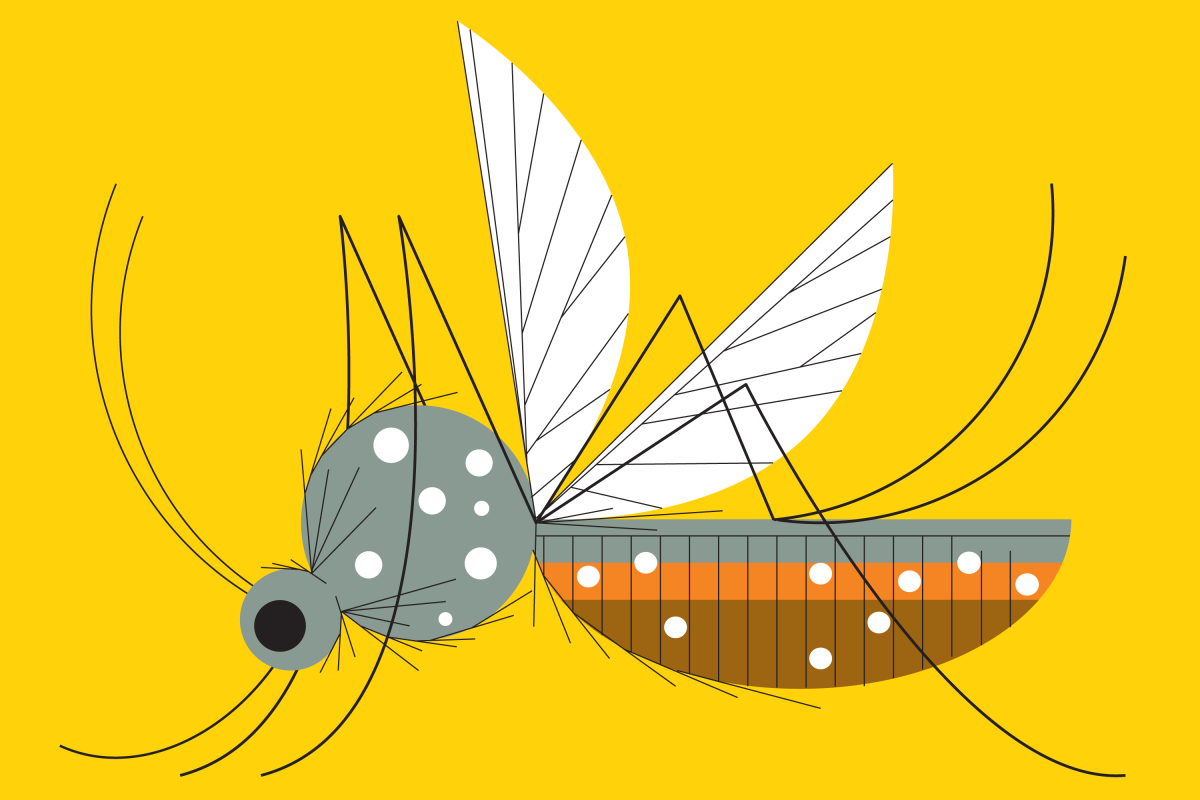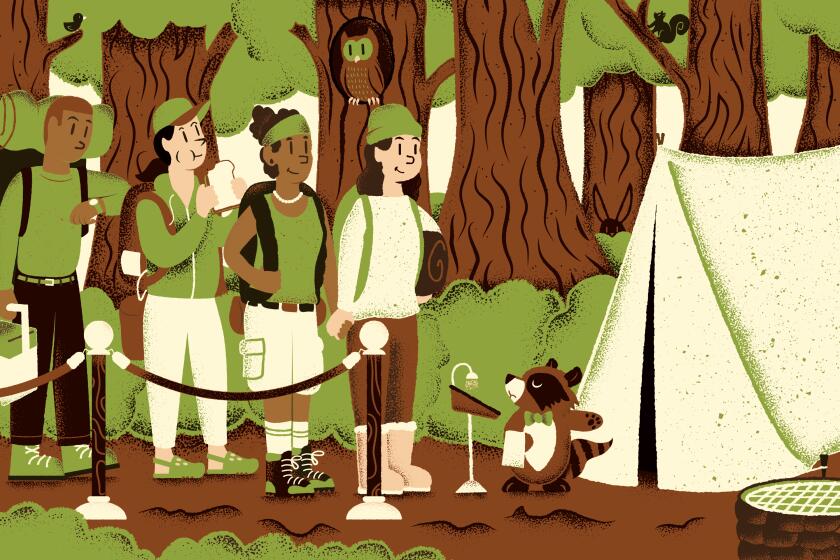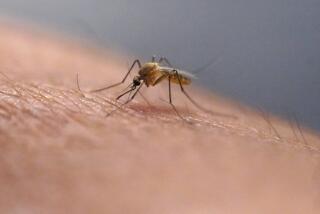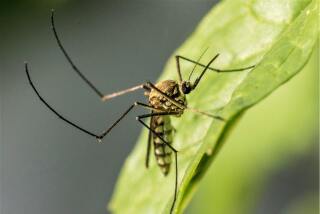How to protect yourself from mosquito bites

- Share via
The hoot of a great horned owl. The munching of a mule deer enjoying grass. The crunching of your feet on the sandy soil. To any hiker, these sounds enhance the joy of being outdoors. But the endorphin rush of a great trail can be blunted by the high-pitched buzz of a mosquito hovering around your neck, trying to score some lunch.
Unfortunately, Southern California’s mosquito season began in early May and there’s no end in sight. This period has grown “longer and longer” according to Susanne Kluh, general manager at Greater Los Angeles County Vector Control District.
“When I started at the district 25 years ago, we pretty much put our [tracking and collection] tools away in the middle of October,” Kluh said. “Now because it stays warm so long, [mosquito season] really goes into late November, sometimes early December.”
Being bitten by a mosquito can result in an itchy, unsightly red bump and — depending on where you are — serious disease. Outbreaks of dengue fever have been seen this year in several countries in Latin America and the Caribbean, underscoring the importance of wearing repellent regardless of where you spend time outdoors.
So I’ve put together an explainer on how to protect yourself while re-creating in Southern California. Trust me, it will come in handy when planning your next camping trip or hike!
Essential things to do, see and eat right now in California, Oregon, Washington, the Baja Peninsula and British Columbia. Ready to explore?
First off, what kinds of mosquitoes inhabit L.A.?
Too many. Los Angeles County is home to several types of mosquitoes, including multiple kinds of culex mosquitoes that spread West Nile virus, usually in the summer months.
Two of the most notorious are the invasive ankle-biting yellow fever mosquito (Aedes aegypti) and Asian tiger mosquito (Aedes albopictus), Kluh said.
Since the 1940s, these little jerks have repeatedly made their way to Southern California. And that includes a large infestation of Asian tiger mosquitoes in 2001 that came over with an ornamental bamboo shipment imported from China. For years they struggled to get established. Then climate change worsened and the Aedes mosquitoes likely adapted. “Every time they live somewhere, they get a little more used to a climate,” Kluh said.
In 2011, L.A. County officials discovered the Asian tiger mosquito in El Monte, which raised alarm bells because of its ability to carry serious illnesses, including dengue and yellow fever in humans, and heartworm in dogs, according to the UC Riverside Center for Invasive Species Research.
Then in 2014, yellow fever mosquitoes were discovered in Commerce and Pico Rivera, which raised similar health concerns. Despite its name, the yellow fever mosquito isn’t transmitting the disease in L.A. County. (But it could if it ever found an infected local host.)
Both species are now established in the L.A. metro area, and we’ve suffered since.
These aggressive daytime biters spread serious diseases outside L.A. like Zika virus, which can cause birth defects among pregnant patients, Chikungunya, which can cause serious long-term joint pain and dengue fever, which can cause high fever and body aches, and occasionally, death.
But all mosquitoes aren’t dangerous. Young mosquitoes generally don’t carry disease and are simply a nuisance. They’re also great snacks for many birds.
You’re not imagining it. Fortunately, there are some DIY ways to keep the critters out of your house and off your skin.
Where do they lay their eggs?
The Southern house mosquito, a type of Culex mosquito, typically lays its eggs in fresh or stagnant water, like a muddy puddle where a seasonal river once flowed. She’ll lay them all at once, creating a raft of 100 to 300 eggs floating on the surface of the water, according to the Centers for Disease Control and Prevention.
Meanwhile, the Aedes mosquitoes lay durable eggs that can sit attached to, for example, a dry water trough. Once hit with a little rain, those eggs hatch.
They “love biting people,” and can breed in tiny places, Kluh said. A beer bottle cap, left by an imprudent camper next to a campfire, is the perfect hatching nook for any L.A. Aedes girl.
Typically, trails with water will attract mosquitoes, as that’s where they go to lay their eggs. The Culex thriambus enjoys areas along rivers and streams in foothill communities. You might also find the Western treehole mosquito (Ochlerotatus sierrensis) on a trail, especially one nearby oak trees. These guys can carry heartworm, which can be devastating to a dog that hasn’t been treated with preventive medicine.
In higher elevations, including parts of the High Sierra, you might even find snowmelt mosquitoes, which breed in puddles left from melting snow. They don’t carry West Nile virus but do enjoy biting people.
Whether you’re looking for ocean views or desert landscapes or soaring mountain peaks, Los Angeles offers miles upon miles of strikingly different trails.
Wow, gross! How do I keep them away?
There are several ways you can protect yourself from mosquitoes. The most effective of them is DEET.
DEET (chemical name, N,N-diethyl-meta-toluamide) is the active ingredient in many insect repellents on the market. It was developed by the U.S. Army in 1946 and then registered for public use in 1957, according to the National Library of Medicine.
The concentration of DEET in a product determines how long it will keep mosquitos away. A product with 10% DEET will protect you for about two hours while a 30% DEET product provides about five hours of protection.
As mosquitoes age, their olfactory system becomes less sensitive, according to Walter S. Leal, a UC Davis distinguished professor in molecular and cellular biology who has researched insects for more than 30 years and studied the effectiveness of DEET and other insect repellents.
So, to ward off disease-carrying older mosquitoes, you’ll need a higher percentage of DEET — somewhere between 20% to 30%.
Researchers have developed other insect repellents, but they never last as long as DEET. That being said, if you’re going to the playground with your child for 30 minutes, Leal says that citronella spray — which is distilled from grass varieties — should work just fine. But if you’re going on a long hike, DEET is the only repellent on the market proven to last up to six hours. “That’s why it is so difficult to beat,” Leal said.
Reservations are often booked up 6 months in advance at some of the most sought-after camping grounds. What’s a procrastinator to do? Consider some of L.A.’s best first-come, first-served sites.
But is DEET safe?
The short answer? Yes. But that yes comes with an asterisk: According to the American Academy of Pediatrics, kids should use insect repellents that contain no more than 30% DEET. (It notes that reports of adverse effects associated with DEET are rare, and when used appropriately, DEET does not present a health risk.)
The CDC recommends using insect repellent, including DEET, if you’re pregnant or nursing. Repeated research has found that DEET is safe for pregnant parents when used as directed.
“[DEET] is the gold standard,” Leal said.
In his lab, he’s tested products with 20% DEET versus products with 20% Picaridin, a synthetic compound developed in the 1980s to resemble the natural piperine, which is found in plants used to make black pepper. Through that work, Leal said he and other scientists have never found a product more long-lasting and overall effective at warding off mosquitoes than DEET.
But DEET has a perception problem because unlike some repellents, it isn’t naturally occurring, Leal said. The public, especially the naturally inclined, take pause with that.
“They want something that’s natural — they forget that strychnine [and] ricin are all natural products,” Leal said, referencing poisons derived from plants. “Being natural does not necessarily mean it is good, and being synthetic doesn’t necessarily mean it is bad.”
Additionally, people often incorrectly associate DEET with the banned insecticide DDT. “This is a big mistake,” Leal said.
There is no chemical similarity between the two. DEET isn’t a pesticide, meaning it repels insects but does not kill them.
Backpacking the Lost Coast should be on every outdoorsy Californian’s bucket list. Here’s what you need to know about its new overnight camping fees.
But can’t my clothes protect me?
Sure they can. While on a hike, wear loose-fitting long-sleeve shirts and pants. You can also invest in clothing treated with insecticide permethrin, or buy a spray with permethrin for treating your tent, gear or clothing (while you’re not wearing it) to help ward off mosquitoes. It is not effective to spray DEET on your clothing, Leal said.
But unless you wear a full-body hazmat suit doused in permethrin, your exposed skin will still be a target for mosquitoes.
OK, fine, I’ll use DEET. How should I apply it?
When wearing both sunscreen and repellent, apply repellent last. If you apply sunscreen last, it will cover the repellent, and mosquitoes will not sense it, Leal said.
Generally, it’s most helpful to apply DEET on bare skin — your neck, hands, ankles, whatever skin is showing. It’s not recommended to use repellent under clothing.
It’s important to remember to reapply repellent as needed, as even DEET will wear off over time.
Anything else I should know?
A mosquito bite here and there is inescapable, but as long as you’re vigilant and embrace the DEET, you will be able to prevent your flesh from becoming lunch.
And keep in mind, the repellent you apply to keep mosquitoes away will also help ward off the other nasties like ticks and black flies. Three pests, one spray!
More to Read
Sign up for The Wild
We’ll help you find the best places to hike, bike and run, as well as the perfect silent spots for meditation and yoga.
You may occasionally receive promotional content from the Los Angeles Times.
















